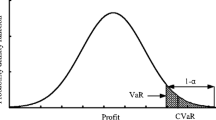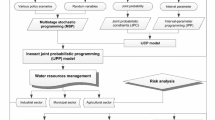Abstract
In this study, a dual interval two-stage restricted-recourse programming (DITRP) method is developed for flood-diversion planning under uncertainty. Compared with other conventional methods, DITRP improves upon them by addressing system uncertainties with complex presentations and incorporating subjective information within its optimization framework. Uncertainties in DITRP can be represented as probability distributions and intervals. In addition, the dual-interval concept is presented when the available information is highly uncertain for boundaries of intervals. Moreover, decision makers’ attitudes towards system risk can be reflected using a restricted-resource measure by controlling the variability of the recourse cost. The method has been applied to a case study of flood management. The results indicate that reasonable solutions for planning flood management practice have been generated which are related to decisions of flood-diversion. Several policy scenarios are analyzed, assisting in gaining insight into the tradeoffs between risk and cost.
Similar content being viewed by others
References
Ahmed S, Sahinidis NV (1998) Robust process planning under uncertainty. Ind Eng Chem Res 37(5):1883. doi:10.1021/ie970694t
Bai D, Carpenter TJ, Mulvey JM (1997) Making a case for robust models. Manage Sci 43:895–907. doi:10.1287/mnsc.43.7.895
Barbaro A, Bagajewicz MJ (2004) Managing financial risk in planning under uncertainty. Process Syst Eng 50(5):963–989
Beraldi P, Musmanno R, Triki C (1998) Solving optimal power dispatch via stochastic linear programming with restricted recourse. Technical report, Department of Electronics, Informatics and Systems, University of Calabria, Rende, Italy
Beraldi P, Grandinetti L, Musmanno R, Triki C (2000) Parallel algorithms to solve two-stage stochastic linear programs with robustness constrains. Parallel Comput 26:1889–1908. doi:10.1016/S0167-8191(00)00057-0
Birge JR, Louveaux FV (1997) Introduction to stochastic programming. Springer, New York, NY
Cheung RK, Chen CY (1998) A two-stage stochastic network model and solution methods for the dynamic empty container allocation problem. Transp Sci 32(2):142–162. doi:10.1287/trsc.32.2.142
Cheung RKM, Powel WB (2000) Shape-A stochastic hybrid approximation procedure for two-stage stochastic programs. Oper Res 48(1):73. doi:10.1287/opre.48.1.73.12452
Dai L, Chen CH, Birge JR (2000) Convergence properties of two-stage stochastic programming. J Optim Theory Appl 106:489–509. doi:10.1023/A:1004649211111
Darby-Dowman K, Barker S, Audsley E, Parsons D (2000) A two-stage stochastic programming with recourse model for determining robust planting plans in horticulture. J Oper Res Soc 51:83–98
Edirisinghe NCP, Ziemba WT (1994) Bounds for two-stage stochastic programs with fixed resources. Math Oper Res 19:292–313. doi:10.1287/moor.19.2.292
Eiger G, Shamir U (1991) Optimal operation of reservoirs by stochastic programming. Eng Optim 17:293–312. doi:10.1080/03052159108941077
Eppen GD, Martin RK, Schrage L (1989) A scenario approach to capacity planning. Oper Res 37:517. doi:10.1287/opre.37.4.517
FEMA (2002) Reducing risk through mitigation. Federal Emergency Management Agency, Washington DC, USA
Huang GH, Loucks DP (2000) An inexact two-stage stochastic programming model for waster resources management under uncertainty. Civ Eng Environ Syst 17:95–118. doi:10.1080/02630250008970277
Huang GH, Baetz BW, Partry GG (1992) A grey linear programming approach for municipal solid waste management planning under uncertainty. Civ Eng Syst 9:319–335. doi:10.1080/02630259208970657
Huang GH, Baetz BW, Partry GG (1995) Grey integer programming: an application to waste management planning under uncertainty. Eur J Oper Res 83:594–620. doi:10.1016/0377-2217(94)00093-R
Infanger G (1994) Planning under uncertainty: solving large-scale stochastic linear programs. Boyd and Fraser, Danvers, MA
Joslyn C (2003) Multi-interval elicitation of random intervals for engineering reliability analysis. In: 2003 Int. Symp. on Uncertainty Modeling and Analysis (ISUMA 03). University of Maryland, USA
Kall P (1979) Computational methods for solving two-stage stochastic linear programming problems. Z Angew Math Phys 30:261–271. doi:10.1007/BF01601939
Kall P, Wallace SW (1994) Stochastic programming. Wiley, New York, NY
Koppol APR, Bagajewicz MJ (2003) Financial risk management in the design of water utilization systems in process plants. Ind Eng Chem Res 42:5249–5255. doi:10.1021/ie0203882
Kouwenberg R, Zenios SA (2001) Stochastic programming models for asset liability management. Technical report, HERMES Center of Excellence on Computational Finance & Economics, University of Cyprus, Nicosia, Cyprus
Laguna M (1998) Applying robust optimization to capacity expansion of one location in telecommunications with demand uncertainty. Manage Sci 44:S101–S110. doi:10.1287/mnsc.44.11.S101
Langewisch AT, Choobineh FF (2004) Mean and variance bounds and propagation for ill-specified random variables. IEEE Trans Syst Man Cybern Part A 34(4):494–506. doi:10.1109/TSMCA.2004.826316
Loucks DP, Stedinger JR, Haith DA (1981) Water resources systems planning and analysis. Prentice-Hall, Englewood Cliffs, NJ
Luo B, Maqsood I, Yin YY, Huang GH, Cohen SJ (2003) Adaptation to climate change through water trading under uncertainty—an inexact two-stage nonlinear programming approach. J Environ Inform 2(2):58–68. doi:10.3808/jei.200300022
Lustig IJ, Mulvey JM, Carpenter TJ (1991) Formulating two-stage stochastic programs for interior point methods. Oper Res 39:757–763. doi:10.1287/opre.39.5.757
Malcolm SA, Zenios SA (1994) Robust optimization of power systems capacity expansion under uncertainty. J Oper Res Soc 45:1040–1049
Maqsood I (2004) Development of simulation- and optimization-based decision support methodologies for environmental systems management. PhD Dissertation, University of Regina
McCray AW (1975) Petroleum evaluations and economic decisions. Prentice Hall, Englewood Cliffs, NJ
Mobasheri F, Harboe RC (1970) A two-stage optimization model for design of a multipurpose reservoir. Water Resour Res 6(1):22–31. doi:10.1029/WR006i001p00022
Mulvey JM, Vanderbei RJ, Zenios SA (1995) Robust optimization of large-scale systems. Oper Res 43:264. doi:10.1287/opre.43.2.264
Needham JT, Watkins DW Jr, Lund JR, Nanda SK (2000) Linear programming for flood control in the Iowa and Des Moines rivers. J Water Resour Plan Manage 126(3):118–127. doi:10.1061/(ASCE)0733-9496(2000)126:3(118)
Olsen JR, Beling PA, Lambert JH (2000) Dynamic models for floodplain management. J Water Resour Plan Manage 126(3):167–171. doi:10.1061/(ASCE)0733-9496(2000)126:3(167)
Prekopa A (1995) Stochastic programming. Kluwer, Dordrecht, The Netherlands
Randall D, Cleland L, Kuehne CS, Buzz GW, Sheer DP (1997) A water supply planning simulation model using mixed-integer linear programming “engine”. J Water Resour Plan Manage 123(2):116–124. doi:10.1061/(ASCE)0733-9496(1997)123:2(116)
Ruszczynski A, Swietanowski A (1997) Accelerating the regularized decomposition method for two-stage stochastic linear problems. Eur J Oper Res 101:328–342. doi:10.1016/S0377-2217(96)00401-8
Sen S (1993) Subgradient decomposition and differentiability of the recourse function of a two stage stochastic linear program. Oper Res Lett 13:143–148. doi:10.1016/0167-6377(93)90003-Y
Srinivasan K, Neelakantan TR, Narayan P (1999) Mixed-integer programming model for reservoir performance optimization. J Water Resour Plan Manage 125(5):298–301. doi:10.1061/(ASCE)0733-9496(1999)125:5(298)
Takriti S, Ahmed S (2004) On robust optimization of two-stage systems. Math Program Ser A 99:109–126. doi:10.1007/s10107-003-0373-y
Uryasev S, Pardalos PM (2001) Stochastic optimization: algorithm and applications. Kluwer, Norwell, MA
Vladimirou H, Zenios SA (1997) Stochastic linear programs with restricted recourse. Eur J Oper Res 101:177. doi:10.1016/0377-2217(95)00370-3
Wang D, Adams BJ (1986) Optimization of real-time reservoir operations with Markov decision processes. Water Resour Res 22:345–352. doi:10.1029/WR022i003p00345
Wang XH, Du CM (2003) An internet based flood warning system. J Environ Inform 2:48–56. doi:10.3808/jei.200300017
Windsor JS (1981) Model for the optimal planning of structural flood control systems. Water Resour Res 17(2):289–292. doi:10.1029/WR017i002p00289
Author information
Authors and Affiliations
Corresponding author
Rights and permissions
About this article
Cite this article
Liu, Z., Huang, G. Dual-Interval Two-Stage Optimization for Flood Management and Risk Analyses. Water Resour Manage 23, 2141–2162 (2009). https://doi.org/10.1007/s11269-008-9375-0
Received:
Accepted:
Published:
Issue Date:
DOI: https://doi.org/10.1007/s11269-008-9375-0




